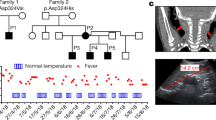Abstract
The death-inducing signaling complex (DISC) formed by the death receptor Fas, the adaptor protein FADD and caspase-8 mediates the extrinsic apoptotic program. Mutations in Fas that disrupt the DISC cause autoimmune lymphoproliferative syndrome (ALPS). Here we show that the Fas–FADD death domain (DD) complex forms an asymmetric oligomeric structure composed of 5–7 Fas DD and 5 FADD DD, whose interfaces harbor ALPS-associated mutations. Structure-based mutations disrupt the Fas–FADD interaction in vitro and in living cells; the severity of a mutation correlates with the number of occurrences of a particular interaction in the structure. The highly oligomeric structure explains the requirement for hexameric or membrane-bound FasL in Fas signaling. It also predicts strong dominant negative effects from Fas mutations, which are confirmed by signaling assays. The structure optimally positions the FADD death effector domain (DED) to interact with the caspase-8 DED for caspase recruitment and higher-order aggregation.
This is a preview of subscription content, access via your institution
Access options
Subscribe to this journal
Receive 12 print issues and online access
$189.00 per year
only $15.75 per issue
Buy this article
- Purchase on Springer Link
- Instant access to full article PDF
Prices may be subject to local taxes which are calculated during checkout




Similar content being viewed by others

References
Park, H.H. et al. The death domain superfamily in intracellular signaling of apoptosis and inflammation. Annu. Rev. Immunol. 25, 561–586 (2007).
Kohl, A. & Grutter, M.G. Fire and death: the pyrin domain joins the death-domain superfamily. C. R. Biol. 327, 1077–1086 (2004).
Chinnaiyan, A.M., O′Rourke, K., Tewari, M. & Dixit, V.M. FADD, a novel death domain-containing protein, interacts with the death domain of Fas and initiates apoptosis. Cell 81, 505–512 (1995).
Strasser, A., Jost, P.J. & Nagata, S. The many roles of FAS receptor signaling in the immune system. Immunity 30, 180–192 (2009).
Wajant, H. The Fas signaling pathway: more than a paradigm. Science 296, 1635–1636 (2002).
Kischkel, F.C. et al. Cytotoxicity-dependent APO-1 (Fas/CD95)-associated proteins form a death-inducing signaling complex (DISC) with the receptor. EMBO J. 14, 5579–5588 (1995).
Huang, B., Eberstadt, M., Olejniczak, E.T., Meadows, R.P. & Fesik, S.W. NMR structure and mutagenesis of the Fas (APO-1/CD95) death domain. Nature 384, 638–641 (1996).
Berglund, H. et al. The three-dimensional solution structure and dynamic properties of the human FADD death domain. J. Mol. Biol. 302, 171–188 (2000).
Jeong, E.J. et al. The solution structure of FADD death domain. Structural basis of death domain interactions of Fas and FADD. J. Biol. Chem. 274, 16337–16342 (1999).
Hill, J.M. et al. Identification of an expanded binding surface on the FADD death domain responsible for interaction with CD95/Fas. J. Biol. Chem. 279, 1474–1481 (2004).
Martin, D.A. et al. Defective CD95/APO–1/Fas signal complex formation in the human autoimmune lymphoproliferative syndrome, type Ia. Proc. Natl. Acad. Sci. USA 96, 4552–4557 (1999).
Rieux-Laucat, F., Le Deist, F. & Fischer, A. Autoimmune lymphoproliferative syndromes: genetic defects of apoptosis pathways. Cell Death Differ. 10, 124–133 (2003).
Bettinardi, A. et al. Missense mutations in the Fas gene resulting in autoimmune lymphoproliferative syndrome: a molecular and immunological analysis. Blood 89, 902–909 (1997).
Fisher, G.H. et al. Dominant interfering Fas gene mutations impair apoptosis in a human autoimmune lymphoproliferative syndrome. Cell 81, 935–946 (1995).
Oliveira, J.B. & Gupta, S. Disorders of apoptosis: mechanisms for autoimmunity in primary immunodeficiency diseases. J. Clin. Immunol. 28 (Suppl 1), S20–S28 (2008).
Scott, F.L. et al. The Fas–FADD death domain complex structure unravels signalling by receptor clustering. Nature 457, 1019–1022 (2009).
Park, H.H. et al. Death domain assembly mechanism revealed by crystal structure of the oligomeric PIDDosome core complex. Cell 128, 533–546 (2007).
Siegel, R.M. et al. Measurement of molecular interactions in living cells by fluorescence resonance energy transfer between variants of the green fluorescent protein. Sci. STKE 2000, Pl1 (2000).
Vaishnaw, A.K. et al. The molecular basis for apoptotic defects in patients with CD95 (Fas/Apo-1) mutations. J. Clin. Invest. 103, 355–363 (1999).
Carrington, P.E. et al. The structure of FADD and its mode of interaction with procaspase-8. Mol. Cell 22, 599–610 (2006).
O' Reilly, L.A. et al. Membrane-bound Fas ligand only is essential for Fas-induced apoptosis. Nature 461, 659–663 (2009).
Dhein, J. et al. Induction of apoptosis by monoclonal antibody anti-APO-1 class switch variants is dependent on cross-linking of APO-1 cell surface antigens. J. Immunol. 149, 3166–3173 (1992).
Muppidi, J.R. & Siegel, R.M. Ligand-independent redistribution of Fas (CD95) into lipid rafts mediates clonotypic T cell death. Nat. Immunol. 5, 182–189 (2004).
Holler, N. et al. Two adjacent trimeric Fas ligands are required for Fas signaling and formation of a death-inducing signaling complex. Mol. Cell. Biol. 23, 1428–1440 (2003).
Tibbetts, M.D., Zheng, L. & Lenardo, M.J. The death effector domain protein family: regulators of cellular homeostasis. Nat. Immunol. 4, 404–409 (2003).
Yang, J.K. et al. Crystal structure of MC159 reveals molecular mechanism of DISC assembly and FLIP inhibition. Mol. Cell 20, 939–949 (2005).
Siegel, R.M. et al. SPOTS: signaling protein oligomeric transduction structures are early mediators of death receptor-induced apoptosis at the plasma membrane. J. Cell Biol. 167, 735–744 (2004).
Xiao, T., Towb, P., Wasserman, S.A. & Sprang, S.R. Three-dimensional structure of a complex between the death domains of Pelle and Tube. Cell 99, 545–555 (1999).
Qin, H. et al. Structural basis of procaspase-9 recruitment by the apoptotic protease-activating factor 1. Nature 399, 549–557 (1999).
Lin, S.C., Lo, Y.C. & Wu, H. Helical assembly in the MyD88–IRAK4–IRAK2 complex in TLR/IL-1R signalling. Nature 465, 885–890 (2010).
Ohi, M., Li, Y., Cheng, Y. & Walz, T. Negative staining and image classification—powerful tools in modern electron microscopy. Biol. Proced. Online 6, 23–34 (2004).
Li, Z., Hite, R.K., Cheng, Y. & Walz, T. Evaluation of imaging plates as recording medium for images of negatively stained single particles and electron diffraction patterns of two-dimensional crystals. J. Electron Microsc. (Tokyo) 59, 53–63 (2010).
Frank, J. et al. SPIDER and WEB: processing and visualization of images in 3D electron microscopy and related fields. J. Struct. Biol. 116, 190–199 (1996).
Sobott, F., Hernandez, H., McCammon, M.G., Tito, M.A. & Robinson, C.V. A tandem mass spectrometer for improved transmission and analysis of large macromolecular assemblies. Anal. Chem. 74, 1402–1407 (2002).
Hernández, H. & Robinson, C.V. Determining the stoichiometry and interactions of macromolecular assemblies from mass spectrometry. Nat. Protoc. 2, 715–726 (2007).
Otwinowski, Z. & Minor, W. Processing of X-ray diffraction data collected in oscillation mode. Methods Enzymol. 276, 307–326 (1997).
Read, R.J. Pushing the boundaries of molecular replacement with maximum likelihood. Acta Crystallogr. D Biol. Crystallogr. 57, 1373–1382 (2001).
Brunger, A.T. et al. Crystallography & NMR system: a new software suite for macromolecular structure determination. Acta Crystallogr. Biol. Crystallogr. 54, 905–921 (1998).
Collaborative Computational Project. N. The CCP4 suite: programs for protein crystallography. Acta Crystallogr. D Biol. Crystallogr. 50, 760–763 (1994).
Delano, W.L. The PyMol Molecular Graphics System (Delano Scientific, 2002).
Baker, N.A., Sept, D., Joseph, S., Holst, M.J. & McCammon, J.A. Electrostatics of nanosystems: application to microtubules and the ribosome. Proc. Natl. Acad. Sci. USA 98, 10037–10041 (2001).
Siegel, R.M. et al. Fas preassociation required for apoptosis signaling and dominant inhibition by pathogenic mutations. Science 288, 2354–2357 (2000).
Herzenberg, L.A., Tung, J., Moore, W.A. & Parks, D.R. Interpreting flow cytometry data: a guide for the perplexed. Nat. Immunol. 7, 681–685 (2006).
Acknowledgements
We thank Y.C. Park for earlier work on this project and K. Rajashankar, I. Kourinov and N. Sukumar for help with data collection . This work was supported by US National Institutes of Health grant R01-AI50872 (H.W.), the Post-doctoral Fellowship Program of Korea Science and Engineering Foundation (KOSEF) (J.K.Y.), the 2008 Long-term Overseas Dispatch Program for Pusan National University's Tenure-track Faculty (S.B.J.), the Biotechnology and Biological Sciences Research Council (A.Y.P.), the Royal Society (C.V.R.) and the Walters-Kundert Trust (C.V.R.). Diffraction data collection was conducted at the Northeastern Collaborative Access Team beam lines of the Advanced Photon Source at Argonne National Laboratory, supported by award RR-15301 from the National Center for Research Resources at the US National Institutes of Health. S.R. was a fellow of the German Academy of Sciences Leopoldina (BMBF-LPD 9901/8-163). T.W. is an investigator of the Howard Hughes Medical Institute.
Author information
Authors and Affiliations
Contributions
H.W. initiated the project and participated in project design and analysis; L.W. provided the samples for EM; L.W. and E.D. performed in vitro mutagenesis experiments; L.W. and Q.Y. performed multi-angle light scattering experiments; J.K.Y., L.W. and S.B.J. grew the crystals and collected the diffraction data; V.K. and H.W. solved the structure; E.D. performed the CD experiments and the salt-dependence experiments; A.J.R., S.R. and T.W. performed the EM experiments; A.C.C. and R.M.S. performed the cell biology experiments; A.Y.P. and C.V.R. performed the mass spectrometry experiments; H.W. made the figures and wrote the manuscript.
Corresponding author
Ethics declarations
Competing interests
The authors declare no competing financial interests.
Supplementary information
Supplementary Text and Figures
Supplementary Tables 1–4 and Supplementary Figures 1–4 (PDF 8664 kb)
Rights and permissions
About this article
Cite this article
Wang, L., Yang, J., Kabaleeswaran, V. et al. The Fas–FADD death domain complex structure reveals the basis of DISC assembly and disease mutations. Nat Struct Mol Biol 17, 1324–1329 (2010). https://doi.org/10.1038/nsmb.1920
Received:
Accepted:
Published:
Issue Date:
DOI: https://doi.org/10.1038/nsmb.1920
This article is cited by
-
Regulation of anoikis by extrinsic death receptor pathways
Cell Communication and Signaling (2023)
-
Autoinhibitory structure of preligand association state implicates a new strategy to attain effective DR5 receptor activation
Cell Research (2023)
-
Strong apoptotic response of testis tumor cells following cisplatin treatment
International Urology and Nephrology (2023)
-
Protein condensation diseases: therapeutic opportunities
Nature Communications (2022)
-
Structural insights into the disruption of TNF-TNFR1 signalling by small molecules stabilising a distorted TNF
Nature Communications (2021)


